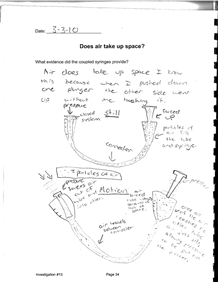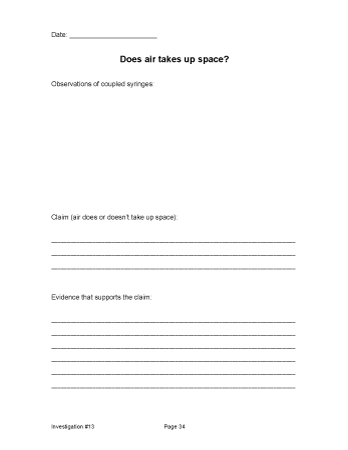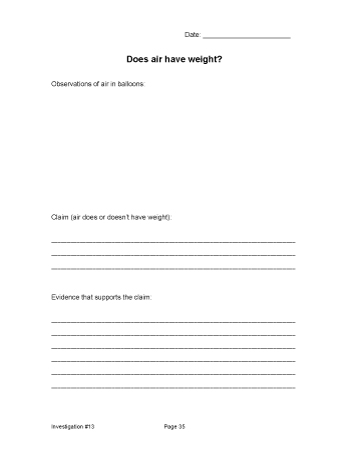Is air matter?
Plan Investigation 13
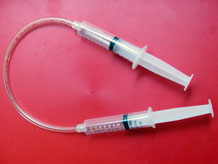
Air is our most familiar example of the state of matter we call gas. We live immersed in it and depend on it to stay alive. It's also invisible, not particularly tangible, and can be challenging to investigate. But, like solids and liquids, air is matter. It has weight (more than we might imagine), it takes up space, and it is composed of particles too small and too spread apart to see. Air, a mixture of gases, shares properties with water vapor, the gaseous form of water that is part of air. Understanding air helps us understand water vapor.
Formative Assessment
Can your students use data to reason that air is matter?
Available online at inquiryproject.terc.edu
Can your students use data to reason that air is matter?
Notebook entries contain evidence that students can use their observational data to make claims that air takes up space and has weight and is, therefore, matter.
Use these criteria to guide your interpretation of student work:
Annotated drawing of syringes
- Does the drawing show that air is continuous from one syringe, through the connecting tube, to the other syringe?
- Does the annotation indicate the student understands that that if you take away space for air in one syringe, the air has to go somewhere else and, therefore, creates this space by pushing on the plunger of the second syringe?
Annotated drawing of inflated balloon
- Does the student explain that that when the balloon with additional air pushes the balance pan down, this is evidence there an increase in weight that must have come from the added air?
Next steps might be a discussion of experiences from everyday life that provide similar evidence that air takes up space and has weight. For example, putting air in a tire pushes the tire out as the air fills the space and increases the weight.
This investigation is the first in a sequence of four in which students investigate the properties of air. In spite of our being able to move freely through air, students establish that air takes up space as they manipulate a system of coupled syringes. Through a convincing balloon demonstration, it is also established that air has weight.
By the end of this investigation students will have evidence that air takes up space, has weight, and, therefore, is matter. Students will be introduced to the idea that air is composed of particles too small and too spread apart to see.
Learning Goals
- Understand that air takes up space, has weight, and is matter composed of particles too small and too spread apart to see
| Sequence of experiences | ||
|---|---|---|
| 1. Ask the question | All Class | 10 Mins |
| 2. Explore air in a closed system | Pairs | 10 Mins |
| 3. Weigh balloons | All Class | 15 Mins |
| 4. Make meaning | All Class | 10 Mins |
Materials and Preparation
Preparation:
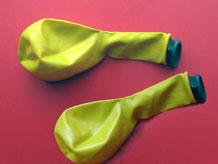
- Cut twelve 16in long pieces from the coil of clear plastic 1/4-inch tubing
- Assemble two sets of 16in double balloons. A double balloon is a set of two balloons, with one balloon inserted into the other balloon. Sliding the balloons over the eraser end of a pencil will help insert one balloon inside the other.
- Press a rubber stopper firmly onto the tip of the balloon pump (See photo).
- Practice using the balloon pump to inflate and tie off a double balloon. Only the inner balloon needs to be tied. Use one hand to squeeze the balloons against the rubber stopper. With the other hand, use rapid, continuous motion of the pump handle to inflate the double balloon to near-maximum size.
- Perfectly balance a double pan balance that has an uninflated double balloon in each pan.
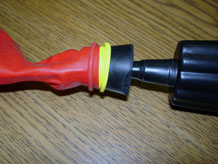
- Post the investigation question in a place where all students can see it.
- Dot Sheet 2 [pdf] (See Resource Quick Links)
- 1 double pan balance, perfectly balanced with an uninflated double balloon in each pan
- 1 balloon pump with rubber stopper inserted onto the tip
- 2 sets of 16in double balloons
- Balloons on a Pan Balance Video
- 2 16in lengths of clear plastic 1/4-inch tubing
- 4 12cc syringes
Concept Cartoon

The Air Has Weight Concept Cartoon is typically used as a formative assessment at the end of this investigation.


